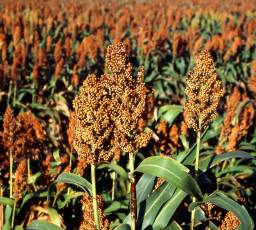Sorghum bicolor
Sorghum bicolor (L.) Moench
Family: Poaceae
Common names: sorghum (Eng.); graansorghum (Afr); mabele (Pedi,Sotho,Ndebele); amabele(Z); amazimba (Xhosa)
Introduction
This crop plant has been cultivated in southern Africa for over 3 000 years.

Description
Description
This is a cane-like grass, up to 6 m tall with large brached clusters of grains. The individual grains are small, about 3-4 mm in diameter. They vary in colour from pale yellow through reddish brown to dark brown depending on the cultivar.

Most cultivars are annuals, few are perennials. Cultivated and most weedy sorghum are non-rhizomatous, culms nodes are either glabrous or shortly tomentose. The inflorescence is contracted. The branches of the inflorescence alternate.
Sorghum bicolor includes all cultivated sorghums as well as a group of semi-wild plants often regarded as weeds.
Wild species are characterized by a distinct ring of long hairs at the nodes. They have loose inflorescences with spreading branches which are whorled. The leaves look much like those of maize, they sometimes roll over. A single plant may have more than two leaves.
The flower head carries two types of flowers: one type has no stalk and has both male and female parts; the other type is stalked and is usually male.
Distribution and habitat
Distribution description
Sorghum bicolor is an African crop, which is widely distributed throughout the world. Different cultivars are found in different regions depending on the climate. It is adapted to a wide range of ecological conditions. It is mostly a plant of hot, dry regions, but will survive in cool climates and in waterlogged habitats.
According to People's Plants 2000 the most common cultivar in South Africa has compact elongated heads and was previously known as S. cafferorum. A form, previously known as S. dochna, with more sparse open heads is often grown for its sweet canes, which are chewed like sugar cane.

Derivation of name and historical aspects
History
Historical records and archaeological data have not been able to clearly state the origin and domestication of Sorghum bicolor. Previously 571 cultivars were recognized. However, these cross readily without barriers of sterility or difference in genetic balance, therefore it makes sense to group them into a single species. It is for this reason that it is not an easy task for taxonomists to work with species but it is an advantage to the plant breeder because they can manipulate the genetic make-up of this group to acquire best crops.
Ecology
Ecology
Self-pollination, and cross-pollination by wind.
Uses
Use
Sorghum is usually grown as a field crop. In Africa there are two basic types — white sorghum, which is sweeter and used as a grain crop, and red sorghum, which is less tasty but is less susceptible to being attacked by birds and makes good beer. Sorghum is also planted for cattle fodder and other purposes.
Sorghum bicolor is an important crop providing food and fodder in the semi-arid tropics of the world. It is a staple food for more than 500 million people in more than 30 countries, although maize has to some extent replaced its use in southern africa. It has been used in the production of alcohol. The whole plant is used for forage, hay or silage. The stem of some types is used for building, fencing, weaving, broom making and firewood. Industrially it can be used for vegetable oil, waxes and dyes.

Growing Sorghum bicolor
Grow
Sorgum is planted from seed, usually in rows in spring. As it is a little more frost-hardy than maize it can be planted up until midsummer if the rains are late. Plant seeds 15 cm apart in rows 1 m apart. Plant seed 3-5 cm deep. Keep watered if no rain falls to germinate the seed. Keep free of weeds, especially while plants are still small.
Sorghum grows in a wide variety of soils and is drought-resistant, but it will do better if the soil is enriched with compost or fertilisers prior to planting. Cultivars have also been selected to suit different soil and climate conditions.
After harvesting, the stalks can be used for cattle food or fuel. It is best to practice crop rotation and only grow sorghum on the same land every 4 years.
Sorghum is prone to various pests, including birds and in some parts of Africa parasitic witchweed (Striga). Crop rotation and early weeding by hand helps with the latter. American bollworm, aphids and borer will need to be controlled with pesticides. Birds will need to be kept from ripening grain sorghum.
References
- Geographical patterns of morphological variations in sorghum (Sorghum bicolour (L.) Moench in Hereditas 129: 195-205 (1998) by Amsalu Ayana and Endashaw Bekele
- The origin of Sorghum bicolour II distribution and domestication De Wet, J.M. and Huckabay J.P.
- Lost crops of Africa, Volume 1: Grains, by Board on Science and Technology for International Development, National Academy Press 1996
- Environmental and Development Agency Trust. 1995. People's Farming Workbook. David Philip. Cape Town
- van Wyk, B-E. & Greicke, N. 2000. People's Plants. Briza. Pretoria.
Credits
E T Rampho
National Herbarium,Pretoria
January 2005
With additions by
Yvonne Reynolds
Plant Attributes:
Plant Type: Grass
SA Distribution:
Soil type:
Flowering season:
PH:
Flower colour:
Aspect: Full Sun
Gardening skill: Average
Special Features:
Horticultural zones










Rate this article
Article well written and informative
Rate this plant
Is this an interesting plant?
Login to add your Comment
Back to topNot registered yet? Click here to register.